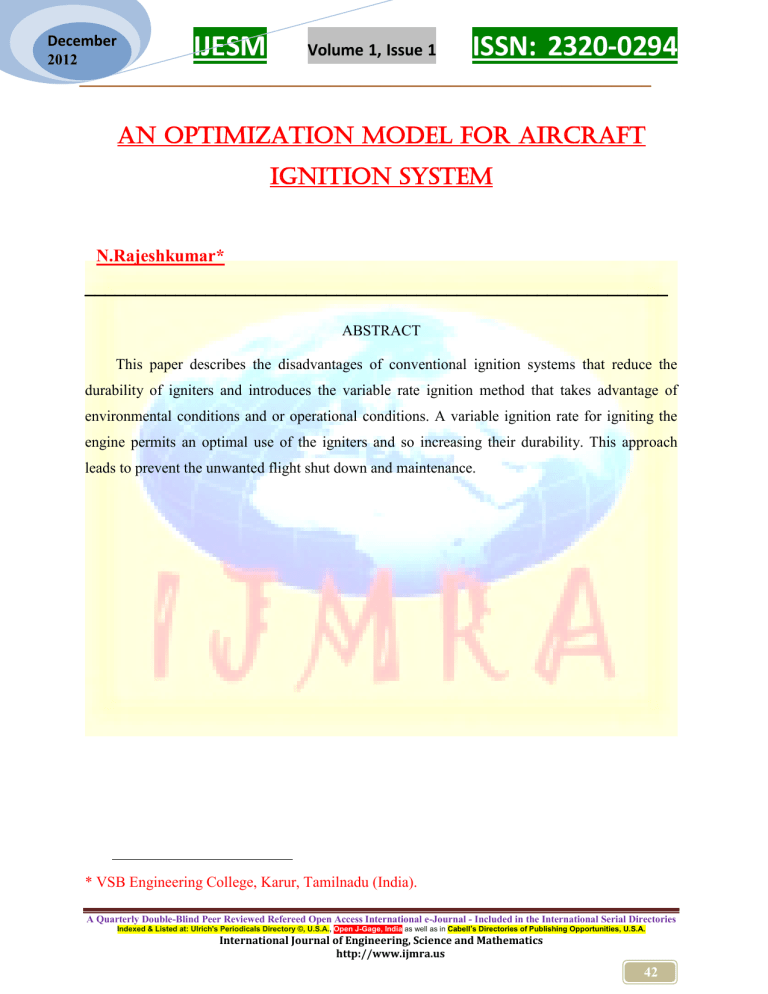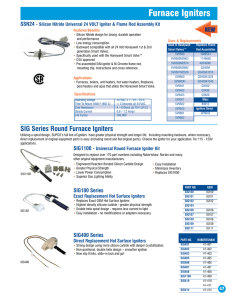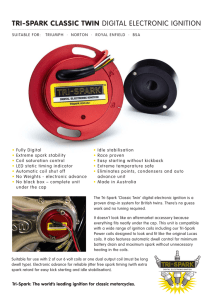IJMRA-ESM2560
advertisement

December 2012 IJESM Volume 1, Issue 1 ISSN: 2320-0294 _________________________________________________________ AN OPTIMIZATION MODEL FOR AIRCRAFT IGNITION SYSTEM N.Rajeshkumar* __________________________________________________________ ABSTRACT This paper describes the disadvantages of conventional ignition systems that reduce the durability of igniters and introduces the variable rate ignition method that takes advantage of environmental conditions and or operational conditions. A variable ignition rate for igniting the engine permits an optimal use of the igniters and so increasing their durability. This approach leads to prevent the unwanted flight shut down and maintenance. * VSB Engineering College, Karur, Tamilnadu (India). A Quarterly Double-Blind Peer Reviewed Refereed Open Access International e-Journal - Included in the International Serial Directories Indexed & Listed at: Ulrich's Periodicals Directory ©, U.S.A., Open J-Gage, India as well as in Cabell’s Directories of Publishing Opportunities, U.S.A. International Journal of Engineering, Science and Mathematics http://www.ijmra.us 42 December 2012 IJESM Volume 1, Issue 1 ISSN: 2320-0294 _________________________________________________________ INTRODUCTION This paper will explain why the lack of absolute certainty in lifetimes of igniters used in gas turbine aircraft engines can impose significant costs on the owners of the aircraft utilizing the engines. The gas turbine engine, containing a combust or Fuel is sprayed into the combustor. An igniter, which functions in a roughly analogous manner to a spark plug in an automobile, produces a spark, or plasma discharge, which initially ignites the jet fuel. After initial ignition, the igniter can be repeatedly sparked thereafter, primarily as a safety measure. That is, in a modern engine, under normal circumstances, it is extremely unlikely for a flame-out to occur in the combustor. However, unexpected situations, such as an abrupt cross-wind, can affect the environment within the combustor, and resulting loss of flame. In addition, certain flight conditions make the unlikely event of a flame-out slightly more probable. Thus, for example, the igniter may be activated when the aircraft enters a rain squall, or other situation which may disturb steady-state conditions in the combustor. The igniters, like all mechanical components, have useful lives which eventually expire, at which time the igniters must be replaced. However, this expiration-and-replacement can create a situation in aircraft which is expensive. A primary reason is that the approach of an igniter to the end of its lifetime is not marked by readily detectable events. That is, at some point, the igniter completely ceases to generate plasma, or spark. However, prior to that point, the igniter may sporadically generate sparks. As explained above, the sparking is not, in general, required to maintain the combustor flame. Consequently, the sporadic sparking would only be noticed if an actual flame-out occurred, and if the sporadic sparking were ineffective to induce are-light. Since such a combination of events is seen as unlikely, the sporadic sparking is not readily noticed. The impending expiration of the useful life of the igniter is similarly not noticed. Another reason is that, while all igniters may be constructed as identically as possible, nevertheless, those igniters do not all possess the same lifetimes. Nor do all igniters experience identical events during their lifetimes. Thus, it is not known exactly when given igniters will expire. Thus, the point in time when an igniter must be replaced is not known with certainty. One approach to solving this problem is to perform preventative maintenance, by replacing the igniters when they are still functioning. While the cost of anew igniter and the manpower required to install it is not great, the early replacement does impose another cost, which can be significant. A Quarterly Double-Blind Peer Reviewed Refereed Open Access International e-Journal - Included in the International Serial Directories Indexed & Listed at: Ulrich's Periodicals Directory ©, U.S.A., Open J-Gage, India as well as in Cabell’s Directories of Publishing Opportunities, U.S.A. International Journal of Engineering, Science and Mathematics http://www.ijmra.us 43 IJESM December 2012 Volume 1, Issue 1 ISSN: 2320-0294 _________________________________________________________ The aircraft in which the igniter is being replaced represents a revenue source measured in thousands of dollars per hour. If the aircraft is rendered non-functional for, say, two hours during replacement of an igniter, the revenue lost during that time is substantial. Therefore, the uncertain lifetimes of igniters in gas turbine aircraft engines can impose significant losses in revenue. In order to prevent the igniters, we can follow the model of ignition system. 1.1 CONVENTIONAL IGNITION SYSTEM The high-energy, capacitor-type ignition system has been universally accepted for gas turbine engines. It provides both high voltage and exceptionally hot spark which covers a large area. Excellent chances of igniting the fuel-air mixture are assured at reasonably high altitudes. The term "high energy" is used throughout this chapter to describe the capacitor-type ignition system. Strictly speaking the amount of energy produced is very small. The intense spark is obtained by expending a small amount of electric energy in a very small amount of time. Energy is the capacity for doing work. It can be expressed as the product of the electrical power (watt) and time. Gas turbine ignition systems are rated in joules. The joule is also an expression of electric energy. It is equal to the amount of energy expended in one second by an electric current of one ampere through a resistance of one ohm. The relationship between these terms can be expressed by the formula W=J/t Where w = watts (power) j = joules t = time (second) All other factors being equal, the spark temperature is determined by the power level reached. A high-temperature spark results from increasing the energy level (1) or shortening the duration (t) of the spark. Increasing the energy level results in a heavier,bulkier ignition unit. Energy delivered to the sparkplug is about 30 to 40 percent of total energy stored in the capacitor. Higher erosion rates on the igniter-plug electrodes occur because of heavy current flowing for a A Quarterly Double-Blind Peer Reviewed Refereed Open Access International e-Journal - Included in the International Serial Directories Indexed & Listed at: Ulrich's Periodicals Directory ©, U.S.A., Open J-Gage, India as well as in Cabell’s Directories of Publishing Opportunities, U.S.A. International Journal of Engineering, Science and Mathematics http://www.ijmra.us 44 December 2012 IJESM Volume 1, Issue 1 ISSN: 2320-0294 _________________________________________________________ comparatively long time. Much of the spark is wasted since ignition takes place in a matter of microseconds (microsecond). On the other hand, since heat is lost to the igniter-plug electrodes and the fuel-air mixture is never completely gaseous; the spark duration cannot be too short. The relationship between watts and time is shown in the following table. The example is for a 4-joule ignition unit (4 joules appearing at the plug). TIME (SECOND) POWER (WATTS) 1 4 0.01 400 0.001 4,000 0.0001 40,000 0.00001 400,000 0.000001 4,000,000 Table1. Watts and time relationship 1.2 EXISTING PROBLEMS IN CONVENTIONAL IGNITION SYSTEM Existing ignition exciters normally have fixed spark rates. These fixed spark rates are designed for an extreme point in the operating envelope of an engine. In order to accommodate this extreme requirement, the exciter has to be set to fire at the fastest rate at all times. This situation has the disadvantage of unduly inducing wear on spark igniters as well as reducing their lives. This results in having to replace igniters earlier than necessary and thereby increases already expensive engine maintenance costs. The stresses associated to the greater number of generated sparks/impulses also results in low durability and high operating costs for conventional exciters. The life time of the igniters is depending upon the no of sparks produced in their life time. A Quarterly Double-Blind Peer Reviewed Refereed Open Access International e-Journal - Included in the International Serial Directories Indexed & Listed at: Ulrich's Periodicals Directory ©, U.S.A., Open J-Gage, India as well as in Cabell’s Directories of Publishing Opportunities, U.S.A. International Journal of Engineering, Science and Mathematics http://www.ijmra.us 45 December 2012 IJESM Volume 1, Issue 1 ISSN: 2320-0294 _________________________________________________________ 2. METHODOLOGY The present approach provides a system for igniting a flow of fuel to a gas turbine engine. The system comprises an engine controller to gather information on at least one of an environmental condition and an operating condition to determine a desired spark rate based on the gathered information. The system further comprises an exciter to command a spark according to the selected spark rate and an igniter to ignite the flow of fuel. Electronic Engine Controller Sensor’s Information Select spark rate Igniters in combustion chamber Figure 1.Flow chart for optimization model The environmental and an operating condition comprises at least one of inlet air temperature, exciter temperature, engine oil temperature, fuel temperature, exciter temperature, exhaust gas temperature, ambient air pressure, fuel pressure and oil pressure. Sensors which are normally found in GTEs or APUs and are capable of sensing environmental and or operational A Quarterly Double-Blind Peer Reviewed Refereed Open Access International e-Journal - Included in the International Serial Directories Indexed & Listed at: Ulrich's Periodicals Directory ©, U.S.A., Open J-Gage, India as well as in Cabell’s Directories of Publishing Opportunities, U.S.A. International Journal of Engineering, Science and Mathematics http://www.ijmra.us 46 IJESM December 2012 Volume 1, Issue 1 ISSN: 2320-0294 _________________________________________________________ conditions. By examine this information; the operational conditions can be determined. For example, a sea level, artic condition, cold soak condition is characterized by cold air, oil and fuel with atmospheric pressure at approximately 1 bar. At sea leve, artic condition start of non cold soaked engine, would differ in that oil and fuel temperature would be above ambient. The later set of condition would require a slower spark rate than the former. In engine controller includes processor in order to select desired spark rate which is used by exciter to produce spark impulse .Igniter receives spark impulse and provides a spark to light a fuel spray for fuel nozzle receiving fuel flow. 3. RESULTS AND CONCULSION These approaches of ignition will avoid replace igniters earlier than necessary and unnecessary maintenance and its expenditure. In next paper we will discuss the system description and its performance. 4. REFERENCES [1] R. Bosch, “Automotive Electric-Electronic Systems”, p.p. 142-158, 1994. [2] S. Hwang, “Simulation of Advance Ignition System for a Four Stroke and Single Cylinder Engine Using Photo and 8751HMicrocontroller”, First IEEE Conference on Control Applications, 907-908, 1992. [3] K. Grote, E. K. Atansson, “Springer Handbook of Mechanical Engineering”, Springer, 2009. [4] T. Denton, “Automobile Electrical and Electronic System”, 3. Edition, 2004. [5]V.A.W.“Hillier, Fundamentals of Automotive Electronics”, Stanley Thornes, 117-141, 1989. [6] M.M. Comber, (1948) "Recent Advances in Aircraft Ignition Systems: The Possibilities of a Low- Voltage Ultra-High Frequency Installation to Avoid Radio Interference", Aircraft Engineering and Aerospace Technology, Vol. 20 Iss: 9, pp.282 – 282. [7] Dr.A.D Kurtz March 1994,”Sensor requirements for active gas turbine engine control”.kulie semiconductor products Inc. A Quarterly Double-Blind Peer Reviewed Refereed Open Access International e-Journal - Included in the International Serial Directories Indexed & Listed at: Ulrich's Periodicals Directory ©, U.S.A., Open J-Gage, India as well as in Cabell’s Directories of Publishing Opportunities, U.S.A. International Journal of Engineering, Science and Mathematics http://www.ijmra.us 47



